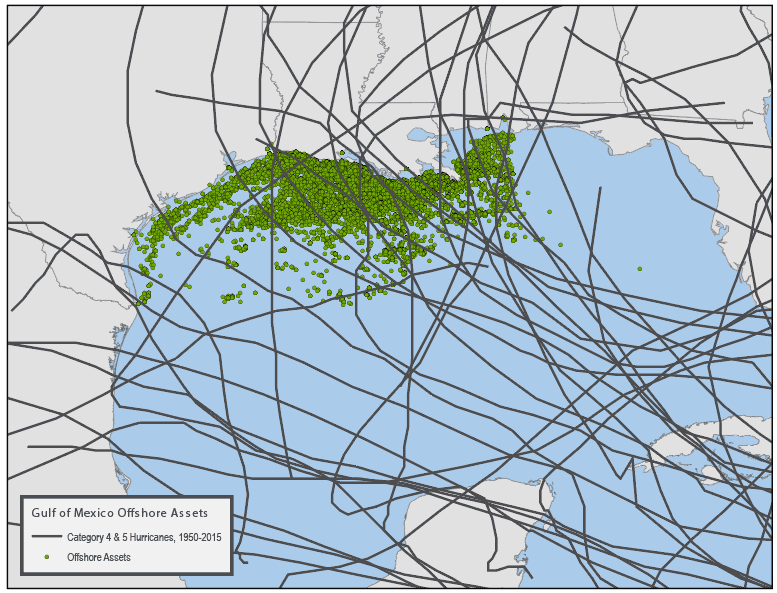Almost 60% of the outstanding catastrophe bond market protects assets along the U.S. Gulf coast. And with new regulation driving a need for increased capitalisation of companies that operate in the region, AIR Worldwide has underlined the importance of ILS in reducing risks for Gulf coast offshore assets.
Analysis of the Artemis Deal Directory reveals that of the $24.9 billion of outstanding catastrophe bond issuance in the market, close to $15 billion, or nearly 60% provides some reinsurance or retrocessional coverage for Gulf coast largely land-based exposures to named storms, hurricanes and wind events.
In a recent report, catastrophe risk modelling firm AIR Worldwide explains that almost 20% of U.S. crude oil is extracted from waters beneath the Gulf, an area that is very susceptible to the production, sustainability and strengthening of tropical cyclone activity.
As a result of this and the need to protect assets and companies that operate along the vulnerable coast-line, insurance-linked securities (ILS) issuance has for a long time been dominant in the area and, new regulation underlines the importance of a continuation of this trend.
“By the end of this September, the Bureau of Ocean Energy Management (BOEM) will have changed the criteria used to determine the amount of financial security a company must maintain for their oil and gas leases in federal waters,” explains AIR Worldwide.
The catastrophe modeller continues to note that the new regulation is to ensure that taxpayers in the U.S. “never have to pay for decommissioning and removing a company’s offshore production facilities,” citing the BOEM.
“These increased capitalization requirements may further strain an industry already facing considerable uncertainty from political, geological, and macro-economic factors,” continued AIR Worldwide, noting that the most uncertain of financial responsibilities relates to the occurrence of hurricanes along the Gulf coast.
This is interesting as it implies a need for insurance capital, rather than reinsurance, with an opportunity for the ILS and catastrophe bond market to demonstrate its relevance as a source of corporate risk transfer and financing.
It’s also a potential opportunity to move the catastrophe bond structure offshore, to protect the type of risks that cat-in-a-box type parametric structures have covered in the past.

Tracks of all Category 4 or greater hurricanes since 1950 over the Gulf of Mexico and the locations of offshore assets. (Source: AIR)
The above image shows all of the Gulf of Mexico offshore assets and all Category 4 or greater hurricanes since 1950, as recorded by AIR Worldwide – revealing just how susceptible offshore, and onshore assets are to damage from intense storms and hurricanes.
While AIR’s article focuses on the Gulf of Mexico, it’s important to remember that the much of the Southern U.S. coastline is susceptible to hurricane activity, and although Florida hasn’t experienced a land-falling hurricane for more than a decade, it only takes one large event to cause billions of dollars of economic and insured losses.
“The burden of increasing capitalization due to regulatory requirements can be offset and balance sheets can be protected by using customized, securitized, and collateralized financial instruments,” says AIR Worldwide.
The bespoke nature of catastrophe bonds enables transactions to be tailored to individual needs, and structures such as a parametric trigger can enable rapid payout post-event, that omits the need for potential timely on-the-ground loss assessment.
“For example, should a storm of significant intensity—say a Category 4 storm or greater—approach certain rigs or cross into a particular block and force a shut-in and evacuation, a payout can be triggered to help protect an exposed balance sheet,” explains AIR Worldwide.
It’s also interesting to consider the very large storm surge risk faced by storage tanks of the oil and gas industry at various locations along the Gulf of Mexico shore. These could be covered from storm surge risk with a parametric trigger, providing a valuable source of capital that would help to clean up any spills after major hurricanes.
The fact is that of the large volume of catastrophe bond issuance outstanding in the market and that has matured, those that protect Gulf coast risks in some form or another, utilise a range of triggers and vary in size, supporting the divergent needs of companies that operate in the region.
However these are largely reinsurance related and any opportunity to expand that to offer risk transfer capacity to energy operators directly on an insurance basis would be a welcome opportunity for the catastrophe bond market and its investors.
With the threat that climate change has the potential to increase the severity and frequency of catastrophe events, and the increased capitalisation needs of companies under new regulation, ILS issuance provides a valuable source of protection to the Gulf coast. This is sure to continue in the coming years and may even expand if the new requirement for capital looks to cat bonds and ILS markets.
 View all of our Artemis Live video interviews and subscribe to our podcast.
View all of our Artemis Live video interviews and subscribe to our podcast.
All of our Artemis Live insurance-linked securities (ILS), catastrophe bonds and reinsurance video content and video interviews can be accessed online.
Our Artemis Live podcast can be subscribed to using the typical podcast services providers, including Apple, Google, Spotify and more.































